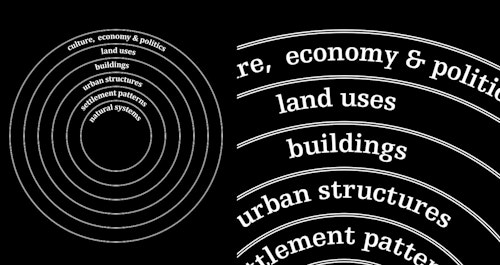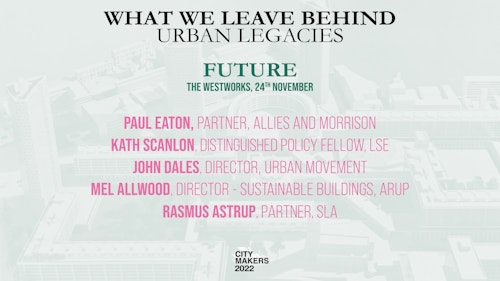/ Citymakers - What we leave behind, Urban Legacies: Future
Can we create cities for the future, when we have no idea what the future will be?
Concluding the tripartite series of 2022’s Citymakers, What we leave behind: Urban legacies, provokes an inevitable gaze forward. The event was hosted at The WestWorks, a 1980s office building renovated by the practice at White City Place. With many speakers calling for a new approach to thinking, a paradigm shift; how do we ensure we design effectively for an uncertain future?
Paul Eaton is thinking big. To the root and scale of our existence to the very patterns of change that we live within. Referencing Stewart Brand’s ‘shearing layers of change’, Paul demonstrates the benefit of this cyclical thinking when approaching urban growth, allowing flexibility and transformation of a structure into a completely new life and use. Paul emphasises the need for economic diversity to give a certain resilience to a place and reinforces the principles of the need for good bones, density and a reminder that cities exist because it’s valuable for people to come together.
Kath Scanlon, Distinguished Policy Fellow at LSE, shares her research into wellbeing in the 21st century high rise. She describes the influential factors determining the types of housing being built and the changing attitudes to tall buildings we’ve seen over the last several decades. Kath reminds us that in the context of the 15 minute city, the importance of getting to the social and economic crux of the tall building typology is essential. We must ask ourselves, who is it really suitable for and what will that mean for city making at higher densities?
John Dales, Director at Urban Movement, sets out the misguided thinking of well-intentioned ‘traffic solutions’ offered in the 20th century and how we have often failed to consider transport in the context of what a city will be rather than as a reactionary response to congestion. John suggests this might have contributed more to city-breaking over city- making, asking, why don’t we provide the transport that is consistent with the future we’re looking for? John asserts that we’re going to need a radical shift in how we travel as transport-as-usual puts traffic before the city leading us further from a sustainable future.
Mel Allwood, Head of Sustainability at Arup, reframes the challenge we face; suggesting it’s of critical importance that we’re asking the right questions rather than focusing on the answers. Mel takes us to her roots, to the south London family home she grew up in. With this Victorian terrace, Mel illustrates the disconnect between our existing legacy and our expectations today. Suggesting that we ask ourselves, what are the minimum resources needed to make something fit for purpose that will last as long as possible? Is it sometimes the right course of action to do nothing at all, to resist the urge to tinker and leave our urban inheritance undisturbed?
Rasmus Astrup, Partner at Danish landscape architecture studio, SLA, brings us back to earth. Reminding us that our cities have become disconnected from nature even though we are all connected to it, dependent on it, and perhaps spending time solving problems that would not have arisen if we’d taken a nature-first approach to begin with. He argues that we can learn from the incredible resilience of the natural word, from its power and capacity to find another way in the face of challenges. Leaving little doubt that we face a crisis of biodiversity, Rasmus shares a thought process from Canada’s First Nations, who consider seven generations in every decision made, he asks, if we took that approach, what would our cities look like?

